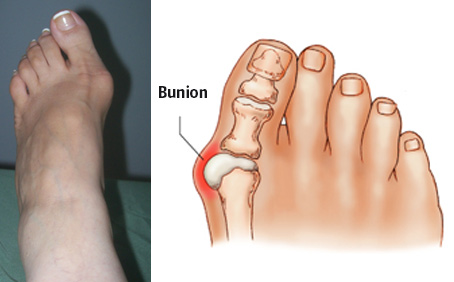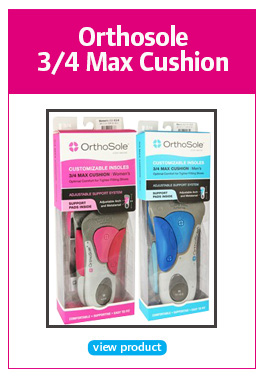
What is a Bunion?
A Bunion is a common condition in which the big toe is deflected towards the outer side of the foot and held there in a fixed position. This creates an enlarged and prominent joint which may become painfully inflamed due to irritation of ill fitting shoes. Over time the big toe may come to rest under or over the 2nd toe. Women run at a higher risk of developing bunions as compared to men. This is mostly because many women tend to wear narrow fitting, high heeled shoes that put unnatural pressures on their feet. As a result their feet are forced into taking irregular shapes that cause these foot problems.
The joint itself may also become painful during walking, as there is limitation of movement or even total fixation in the joint. When the foot is about to push off the ground the force exerted on the joint is great, but the joint can not flex and therefore becomes painful.
What causes a Bunion?
Some suggest that the hereditary factor is the cause of bunions. This is not quite true; though it is the case that the shape of a person’s foot is determined to some extent by genetics, just like other parts of the body, it is also accepted that with proper foot care the incidents of inherited bunions can be dramatically reduced.
The main cause of bunions is incorrect function of the foot during walking (poor biomechanics). Because the foot is in-rolling, the toes turn out and great pressure is then applied on the big toe joint which over the years gives way and the toe is then pushed further out, constantly damaging the joint.
Reduce the development of a Bunion
• It is therefore very important to wear good shoes that can accommodate the enlarged joint. In the first place a bunion should be treated conservatively by fitting in insoles or orthotics device that will eliminate the in-rolling of the foot and therefore reduce the force on the big toe joint. The Orthosole 3/4 Max Cushion Insoles shift the weight away from the inside of the foot when walking protecting the bunion from getting any worse. Orthosole 3/4 Max Cushion Insoles are
designed to reduce foot fatigue and enhance natural foot function and
are biomechanically engineered to help relieve bunion pain.
• Provide cushion and comfort to bunions with pads – Silipos Bunion Care Gel Sleeve – Cushions, protects, and reduces pressure on the affected area with medical grade mineral oil gel pad, Anatomically designed gel pad conforms to the shape of the bunion, Alleviates friction and pressure.
• Epitact Corrective Bunion Orthosis corrects and limits the development of bunions, fits all kinds of shoes and in contrast to rigid orthoses it acts on all factors aggravating the deformity.
• Always wear broad sandals and shoes to avoid pressure on the inflamed joints. Try avoid high heeled shoes.
• Podopro Toe Spreaders can be used for 5 to 15 minutes a day to treat hammertoes, overlapping toes or bunions. These are waterproof which allows you to stretch your toes in the foot spa or bath.
Exercises For Bunions
• Stretching your toes can be very beneficial as exercising your toes and feet increases circulation, red blood activity and bone realignment. By using a flexible gel toe stretcher placed between your toes helps to straighten your toes. Exercise the joint as much as possible in order to keep it mobile as long as possible. The more the joint is fixed the more painful the condition becomes. Always exercise when the foot is nice and warm.
• Activate your arches by working out your tibialis anterior which runs from the base of the big toe through to the front part of the arch of the foot. Give this muscle a workout by practising picking up a tissue with your toes.
• Hold the big toe with one hand and rotate the toe in all directions, pausing the position for 10 seconds at the end range of motion. Repeat several times in all directions.
Sitting on a chair with your knees bent and feet parallel, lift your small toes and extend only your big toe forward and down toward the floor. This action is your the key to battling a bunion, provided that you:
• Keep the lift of the arch. This provides the resistance you need to strengthen the muscles along the instep of the foot.
– Ground your big toe mound and inner heel to keep the arch strong, and avoid simply inverting the foot.
– Lift the big toe up as though you are extending it forward to push a button as it comes down.
• Raise all your toes and extend only your little toes out and down to the floor. This is a good exersise for the muscles running from the little toe along the outer shin and even along the outer thigh, strengthening the alignment on the outer side of the foot.
If the condition becomes very painful and debilitating, you will be wise to seek medical advice from your HPC Registered Podiatrist, Physiotherapist or your GP.




Leave a Reply